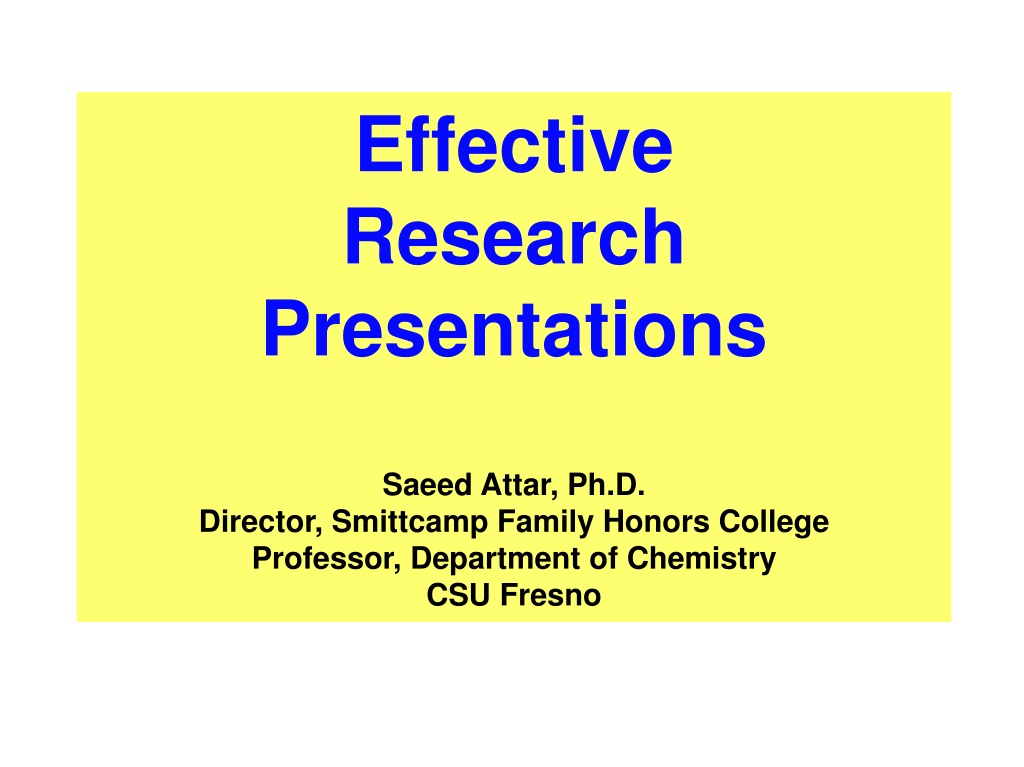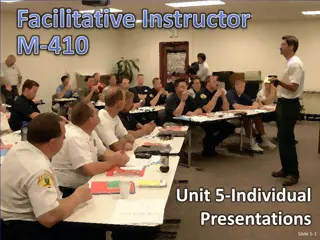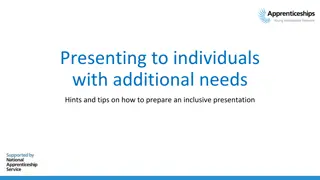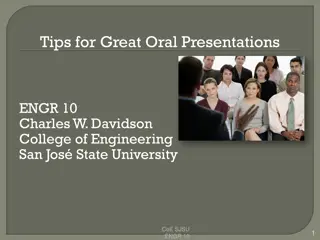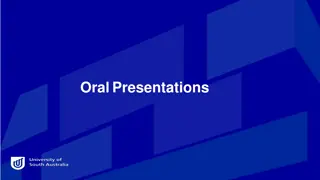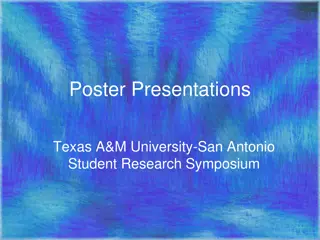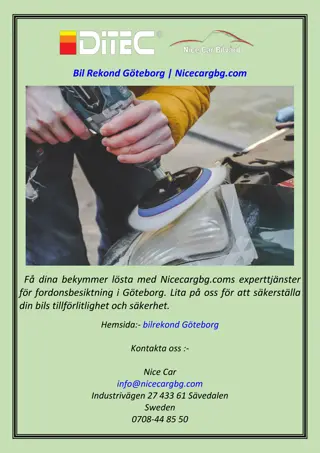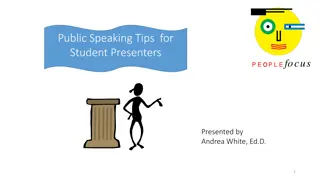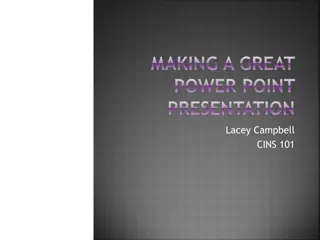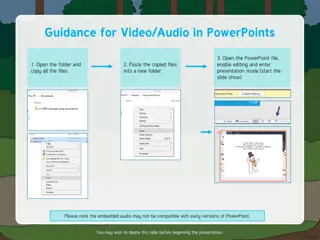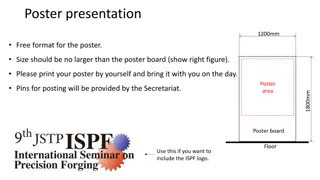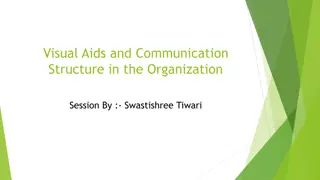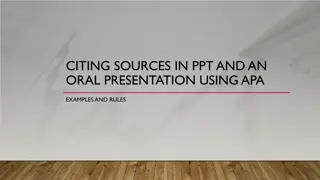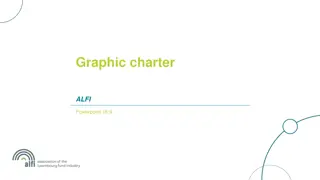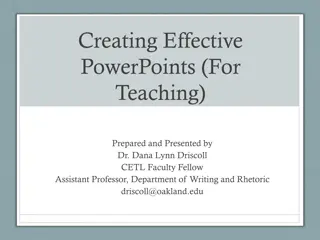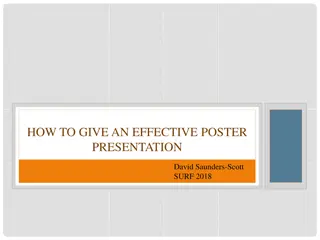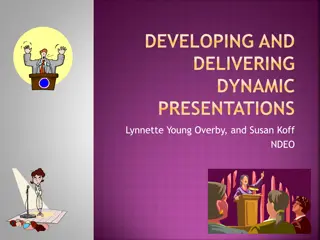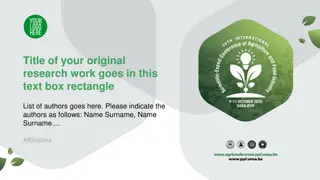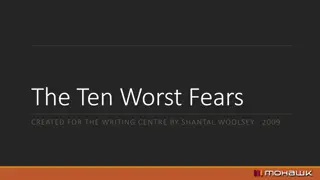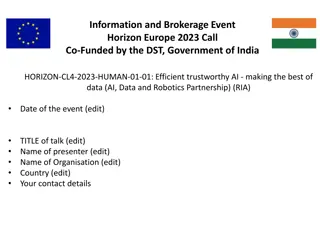Effective Research Presentations: Tips and Strategies for Success
Before preparing for a research presentation, consult with your mentor, understand intellectual property considerations, and research your topic thoroughly. Common methods include poster and oral presentations, both following similar structures. Effective posters are concise, well-organized, and visually appealing. Consider factors like audience size and scientific message when designing your poster. Overall, clear communication and enthusiasm are key to delivering a successful research presentation.
Download Presentation

Please find below an Image/Link to download the presentation.
The content on the website is provided AS IS for your information and personal use only. It may not be sold, licensed, or shared on other websites without obtaining consent from the author. Download presentation by click this link. If you encounter any issues during the download, it is possible that the publisher has removed the file from their server.
E N D
Presentation Transcript
Effective Research Presentations Saeed Attar, Ph.D. Director, Smittcamp Family Honors College Professor, Department of Chemistry CSU Fresno
General Considerations BEFORE You Start Preparing for Your Presentation 1. Consult with your research mentor! A matter of courtesy to your mentor Proper acknowledgement must be given to all team members 2. Can the information be disclosed at this time? Ownership of intellectual property 3. Do your homework well! There is a story to every research project - know yours well!
Common Methods of Communicating Results of Scientific Research 1. Poster presentation 2. Oral presentation
Common Features Between Oral & Poster Presentations 1. Background / introduction 2. Main question; purpose and/or significance 3. Methods 4. Results 5. Interpretation / discussion of results 6. Conclusions / future work 7. References (normally given along the talk) 8. Acknowledgements
Effective Poster Presentations
When is a Poster Appropriate? 1. Fear of public speaking! 2. When you have a contained body of work A single experiment or related sets of expts. Example: work done by an UG student 3. Opportunity for meaningful one-to-one discussion 4. A poster can be appreciated long after its official use
Features of an Effective Poster 1. Clear statement of the research problem 2. Clear statement of the conclusion(s) reached 3. Minimal use of words 4. Readable font 5. Clearly organized and labeled graphs and diagrams 6. Simple and neat look; pleasing to the eye 7. Enthusiasm of the author / presenter
Factors to Consider in Designing a Poster 1. Know your audience Large/national meetings vs. small/local meetings Common mistake: over- or under-estimating the audience s familiarity with your subject 2. Overall considerations Scientific message What is the best way to communicate it? Physical aspects
Physical Aspects of Designing a Poster General Comments 1. Dimensions of the space allotted to you 2. Layout and size of panels 3. Text vs. graphic A picture = 1000 words! 4. Colors to use 5. Something to catch the eye? Rule of thumb: keep it simple! Remember: it is very easy to overdo this!
Physical Aspects of Designing a Poster Specific Comments 1. Heading should match that in the printed program 2. Keep the text to a minimum Average length of a visitor s stay < 5 minutes! 3. Clearly state the research question 4. Summarize your results as much as possible 5. Conclusion(s): the take-home message Make it brief Make it concise The answer to your research question 6. DO NOT forget the acknowledgements!
Physical Aspects of Designing a Poster The Cosmetic Aspect! 1. Legibility: use minimum of 24-point letters 2. Use boldface and/or italicized letters judiciously 3. Guide readers through your poster Use a columnar arrangement of panels if possible Use numbers or arrows to guide the reader 4. Keep number of panels to a minimum 5. Use PowerPoint or other software Makes editing much easier Will show you how to do this today!
Further Preparation for Presenting a Poster 1. Be ready to give each visitor a brief summary of your work 2. Prepare a brief synopsis of your work One-page limit Easily done in PowerPoint Have photocopies ready for visitors 3. Be available for questions and comments! 4. Avoid chatting constantly with your neighbor or your research group fan club so as to miss any visitors! 5. Be sure your name tag is visible! 6. You do not have to have an answer for every question that you are asked!
Summary of the Tips for Poster Presentations 1. Think big! Use font size of at least 24 points 2. Fewer words & more graphics Brief Introduction and Conclusions sections (text) Properly labeled figures, tables, schemes 3. Simple is beautiful! Judicious use of color, boldface, and italics 4. Organize Provide a means for the visitors to follows the flow 5. Sell your poster to the audience! Look professional Be enthusiastic Be ready to provide a brief summary of your work
Effective Oral Presentations
Tips for Delivering an Effective Oral Presentation 1. Write out your talk beforehand Ensures that all important ideas are covered Ensures that difficult ideas are explained effectively 2. Organize your talk appropriately Use an outline Beginning, middle, and end sections The whole-part-whole idea Brief introduction Clear statement of the research question and its significance in a broader context Plenty of time to explain results & their interpretation Time for questions
Tips for Delivering an Effective Oral Presentation 3. Imagine each slide that you have prepared Explain it to yourself orally Then write down what you said Ensures that your talk sounds natural / conversational 4. Do not read your slides word for word Implies lack of preparation Will distance you from the audience 5. Practice, practice, practice! In front of a critical audience well in advance Ask for constructive criticism Do not go over allotted time
Tips for Delivering an Effective Oral Presentation 6. Number of slides Not too many slides! Rule of thumb: 1 min. per slide 7. Simplicity of slides Not too much information per slide Figures / tables should demonstrate main points Beware of frills! It is very easy to overdo this! 8. Readability of slides Use a large and easily readable font (e.g. Arial) Use a minimum of 24-point font size Check for misspelled words! If you have to apologize for a slide, do not show it!
Tips for Delivering an Effective Oral Presentation 9. Use of color in the slides Use primary colors that provide good contrast This is easily readable from every location in the room This is easily readable from every location in the room This is easily readable from every location in the room This is NOT easily readable from every location in the room This is impossible to read from any location in the room! This is very difficult to read from any location in the room! Remember again:it is veryeasy to overdo this!
Tips for Delivering an Effective Oral Presentation 10. Before the talk Arrive early Familiarize yourself with the room 11. Beginning your talk Thank the person who introduced you Begin your talk decisively (no um, OK, or let s see Establish eye contact immediately 12. During your talk Keep your talk simple (avoid excessive detail) Talk to the audience Speak slowly, clearly, and loudly Resist filler words (um, ah, etc.) Use a laser pointer sparingly 13. Ending your talk End it decisively!
Summary of the Tips for Oral Presentations 1. Practice, practice, practice 2. Be professional! 3. Show enthusiasm 4. Be confident and at ease! Finally .. Enjoy your presentation! It is a great learning experience!
